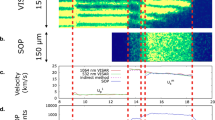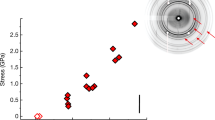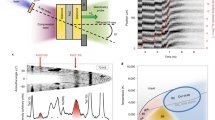Abstract
The Earth's lower mantle consists mainly of (Mg,Fe)SiO3 perovskite and (Mg,Fe)O magnesiowüstite, with the perovskite taking up at least 70 per cent of the total volume1. Although the rheology of olivine, the dominant upper-mantle mineral, has been extensively studied, knowledge about the rheological behaviour of perovskite is limited. Seismological studies indicate that slabs of subducting oceanic lithosphere are often deflected horizontally at the perovskite-forming depth, and changes in the Earth's shape and gravity field during glacial rebound indicate that viscosity increases in the lower part of the mantle. The rheological properties of the perovskite may be important in governing these phenomena. But (Mg,Fe)SiO3 perovskite is not stable at high temperatures under ambient pressure, and therefore mechanical tests on (Mg,Fe)SiO3 perovskite are difficult. Most rheological studies of perovskite have been performed on analogous materials2,3,4,5,6,7, and the experimental data on (Mg,Fe)SiO3 perovskite are limited to strength measurements at room temperature in a diamond-anvil cell8 and microhardness tests at ambient conditions9. Here we report results of strength and stress relaxation measurements of (Mg0.9Fe0.1)SiO3 perovskite at high pressure and temperature. Compared with the transition-zone mineral ringwoodite10 at the same pressure and temperature, we found that perovskite is weaker at room temperature, which is consistent with a previous diamond-anvil-cell experiment8, but that perovskite is stronger than ringwoodite at high temperature.
This is a preview of subscription content, access via your institution
Access options
Subscribe to this journal
Receive 51 print issues and online access
$199.00 per year
only $3.90 per issue
Buy this article
- Purchase on Springer Link
- Instant access to full article PDF
Prices may be subject to local taxes which are calculated during checkout


Similar content being viewed by others
References
Anderson, D. L. & Bass, J. D. Transition region of the Earth's upper mantle. Nature 320, 321–328 (1986)
Poirier, J. P., Peyronneau, J., Gesland, J. Y. & Brebec, G. Viscosity and conductivity of the lower mantle: an experimental study on a MgSiO3 perovskite analogue, KZnF3 . Phys. Earth Planet. Inter. 32, 273–287 (1983)
Doukhan, N. & Doukhan, J. C. Dislocation in perovskite BaTiO3 and CaTiO3 . Phys. Chem. Miner. 13, 403–410 (1986)
Karato, S.-i. Plasticity-crystal structure systematics in dense oxides and its implications for the creep strength of the Earth's deep interior: a preliminary result. Phys. Earth Planet. Inter. 55, 234–240 (1989)
Karato, S.-i. & Li, P. Diffusion creep in perovskite: implications for the rheology of the lower mantle. Science 255, 1238–1240 (1992)
Li, P., Karato, S.-i. & Wang, Z. High-temperature creep in fine-grained polycrystalline CaTiO3, an analogue material of (Mg,Fe)SiO3 perovskite. Phys. Earth Planet. Inter. 95, 19–36 (1996)
Wright, K., Price, G. D. & Poirier, J. P. High-temperature creep of the perovskite CaTiO3 and NaNbO3 . Phys. Earth Planet. Inter. 74, 9–22 (1992)
Meade, C. & Jeanloz, R. The strength of mantle silicates at high pressures and room temperature: implications for the viscosity of the mantle. Nature 348, 533–535 (1990)
Karato, S.-i., Fujino, K. & Ito, E. Plasticity of MgSiO3 perovskite: the results of microhardness tests on single crystals. Geophys. Res. Lett. 17, 13–16 (1990)
Chen, J., Inoue, T., Weidner, D., Wu, Y. & Vaughan, M. Strength and water weakening of mantle minerals, olivine, wadsleyite and ringwoodite. Geophys. Res. Lett. 25, 575–578 1103–1104 (1998)
Weidner, D. J., et al. High-pressure Research: Application to Earth and Planetary Sciences (eds Syono, Y. & Manghnani, M. H.) 13–17 (Terra Scientific/AGU, Tokyo/Washington DC, 1992)
Weidner, D. J., Wang, Y. & Vaughan, M. T. Yield strength at high pressure and temperature. Geophys. Res. Lett. 21, 753–756 (1994)
Weidner, D. J., Wang, Y., Chen, G., Ando, J. & Vaughan, M. T. Properties of Earth and Planetary Materials at High Pressure and Temperature (eds Manghnani, M. H. & Yagi, T.) 473–482 (Geophysical Monograph, AGU, Washington DC, 1998)
Decker, D. L. High-pressure equation of state for NaCl, KCl and CsCl. J. Appl. Phys. 42, 3239–3244 (1971)
Gerward, L., Morup, S. & Topsoe, H. Particle size and strain broadening in energy-dispersive x-ray powder patterns. J. Appl. Phys. 47, 822–825 (1976)
Frost, H. J. & Ashby, M. F. Deformation-Mechanism Maps (Pergamon, Oxford, 1982)
Wang, Y., Guyot, F., Yeganeh-Haeri, A. & Liebermann, R. C. Twinning in MgSiO3 perovskite. Science 248, 468–471 (1990)
Sapriel, J. Domain-wall orientations in ferroelastics. Phys. Rev. B 12, 5128–5140 (1975)
Toledano, J. C. & Toledano, P. Order parameter symmetries and free-energy expansions for purely ferroelastic transitions. Phys. Rev. B 21, 1139–1172 (1980)
Zhao, Y. et al. High-pressure crystal chemistry of neighborite, NaMgF3: An angle-dispersive diffraction study using monochromatic synchrotron x-radiation. Am. Mineral. 79, 615–621 (1994)
Avé Lallemant, H. G. Experimental deformation of diopside and websterite. Tectonophysics 48, 1–27 (1978)
Derby, B. Deformation Processes in Minerals, Ceramics and Rocks (eds Barber, D. J. and Meredith, P. G.) 354–364 (Unwin Hyman, London, 1990)
Shimuzu, I. Stress and temperature dependence of recrystallized grain size: A subgrain misorientation model. Geophys. Res. Lett. 25, 4237–4240 (1998)
Gurnis, M. & Hager, B. H. Controls of the structure of subducted slabs. Nature 335, 317–321 (1988)
Karato, S.-i., Riedel, M. R. & Yuen, D. A. Rheological structure and deformation of subducted slabs in the mantle transition zone; implications for mantle circulation and deep earthquakes. Physics Earth Planet. Inter. 127, 83–108 (2001)
Griggs, D. T. & Baker, D. W. Properties of Matter Under Unusual Conditions (eds Mark, H. & Fernbach, S.) 23–42 (Wiley/Interscience, New York, 1969)
Ogawa, M. Shear instability in a viscoelastic material as the cause of deep focus earthquakes. J. Geophys. Res. 92, 13801–13810 (1987)
Weidner, D. J. et al. Subduction zone rheology. Phys. Earth Planet. Inter. 127, 67–81 (2001)
Acknowledgements
This work was carried out at the X17B beamline of the National Synchrotron Light Source. We thank Z. Zhang, J. B. Hastings and D. P. Siddons for technical support at the beamline, and J. Zhang for help in sample preparation. This work was supported by the US National Science Foundation.
Author information
Authors and Affiliations
Corresponding author
Ethics declarations
Competing interests
The authors declare that they have no competing financial interests.
Rights and permissions
About this article
Cite this article
Chen, J., Weidner, D. & Vaughan, M. The strength of Mg0.9Fe0.1SiO3 perovskite at high pressure and temperature. Nature 419, 824–826 (2002). https://doi.org/10.1038/nature01130
Received:
Accepted:
Issue Date:
DOI: https://doi.org/10.1038/nature01130
This article is cited by
-
Toroidal diamond anvil cell for detailed measurements under extreme static pressures
Nature Communications (2018)
-
Effect of temperature on the electrical properties of nanocrystalline CaTi1−x Fe x O3−Δ perovskite
Journal of Materials Science: Materials in Electronics (2016)
-
Texture development and slip systems in bridgmanite and bridgmanite + ferropericlase aggregates
Physics and Chemistry of Minerals (2016)
-
Peierls dislocation modelling in perovskite (CaTiO3): comparison with tausonite (SrTiO3) and MgSiO3 perovskite
Physics and Chemistry of Minerals (2009)
-
In situ strength measurements on natural upper-mantle minerals
Physics and Chemistry of Minerals (2008)
Comments
By submitting a comment you agree to abide by our Terms and Community Guidelines. If you find something abusive or that does not comply with our terms or guidelines please flag it as inappropriate.



